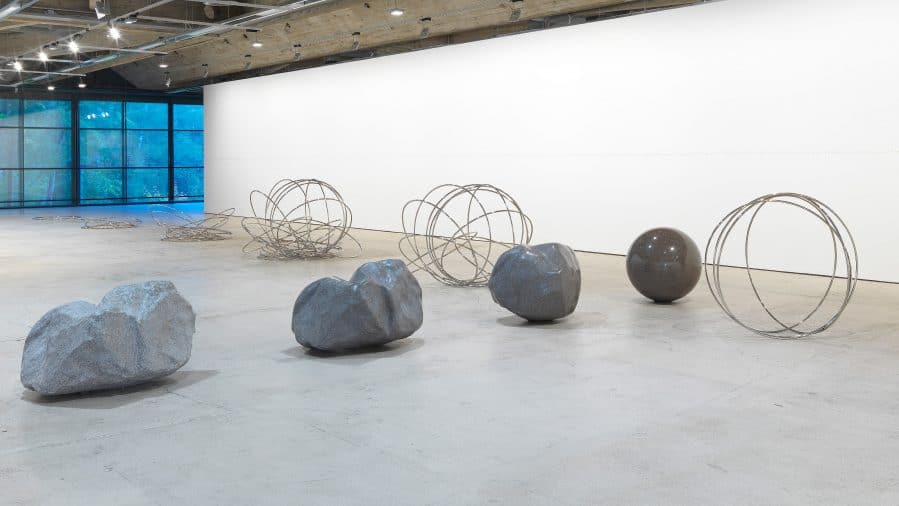Known for sculptural installations that disrupt viewers’ perception of time and space as fixed organising systems, Alicja Kwade draws from physics and philosophy to create works that test the limits of the known. At the Espoo Museum of Modern Art (EMMA) the Polish-German artist presents five installations that spill into one another, resulting in an immersive conglomeration of textures, forms, and materials. The show was commissioned by the Saastamoinen Foundation, which will acquire the work for which exhibition is named, Trans-For-Men (Fibonacci). Composed of a series of boulders that progressively morph into geometric shapes, this titular piece stands in the center of the gallery, where it intersects with the installations 88 Seconds and Shift Slot (Tree), confounding any clear sense of where one work ends and another begins. Each installation is comprised of a series repeating forms that gradually shift and transmute as they unfold across the room and encounter each other. Kwade pulls apart the conventions and systems of measurement used to create a commonly shared understanding of reality, and instead gestures toward an otherwise of endless alternative possibilities.

Alicja Kwade, “Trans-For-Men”, exhibition, Espoo Museum of Modern Art
Static objects hint at movement, most notably in 88 Seconds, a series of steel sculptures that depict a ring as it spins and eventually falls flat against the ground. A recurring motif throughout Kwade’s body of work, the circle references planetary orbits and the infinite, but also circulation—the continuous flow of goods and services. Kwade’s work reminds us how capitalism has increasingly become, like time, an omnipresent yet invisible force structuring everyday lived experience, often accepted as universal while, in fact, remaining deeply tied to forces of power. In 111 days and 22 hours, perhaps the simplest and most poetic work included in the exhibition, Kwade lines the gallery walls with a procession of delicate brass watch hands, which count out the exhibition space in five-minute increments of time. Here, the artist draws attention to the arbitrariness of measurement systems, illustrating how time can be reimagined as spatial units.
The accumulation of these thousands of tiny minute hands also points to the relation between time and production, a connection echoed by the space itself. EMMA is located in a former printing house, a history that Kwade directly engaged with when planning the exhibition and producing new work for it. The site served not only as a space for the production of consumer goods, but also the dissemination of thought and ideas through the publications it manufactured. Like time and space, language also functions as a shared meaning-making system essential to the construction of reality, but one that is inevitably governed by rules, conventions, and hierarchies.

Alicja Kwade, “Trans-For-Men”, exhibition, Espoo Museum of Modern Art
The former factory’s architecture is especially suited to highlight Kwade’s work, particularly the two installations made specifically for the exhibition—Shift Slot (Tree) and Trans-For-Men (Fibonacci). In these two works, the artist mixes natural and manufactured materials. Shift Slot (Tree) features copper cylindrical sculptures that sprout tree branches of varying sizes. While the stones that make up Trans-For-Men (Fibonacci) were created using 3D modeling technology and an algorithm based on the Fibonacci sequence, they were each based on data gleaned from an original, naturally-occurring boulder. The exhibition space’s wall-to-floor windows reveal the lush forest immediately outside, while simultaneously serving as the physical barrier separating the natural environment from the built interior. This context underscores questions about the uneasy distinction between the natural and the fabricated that often come up in Kwade’s work.
The decision to present all works in a single gallery is effective; their impact is greatly enhanced by their combination. Putting Kwade’s installations not only in conversation but also in confrontation with each other adds valuable layers to the work that wouldn’t be as accessible if they were treated as separate, self-contained pieces. Together, they transform the room into another world, yet one that is ultimately just another expression of our own, as the windows visible in the background aptly remind us.
Written by Lexington Davis

Alicja Kwade, “Trans-For-Men”, exhibition, Espoo Museum of Modern Art








